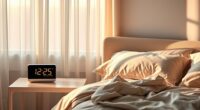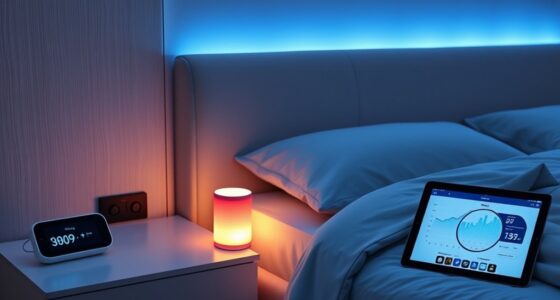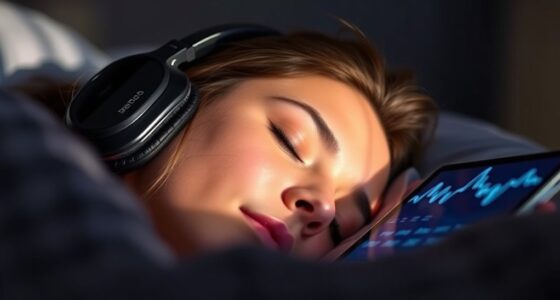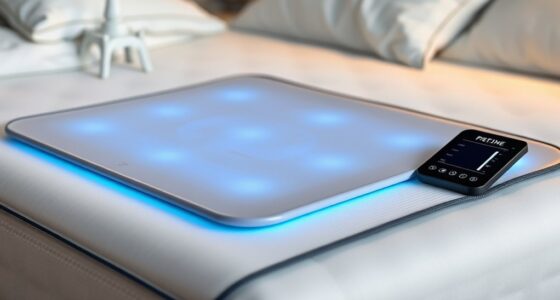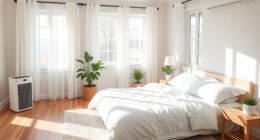Sleep trackers use sensors like accelerometers and heart rate monitors to monitor your movements, heart rate, and breathing during sleep. Algorithms analyze this data to determine sleep stages—light, deep, REM—and track restlessness or tossing. They also assess breathing patterns, which can reveal disruptions or health issues. By combining these metrics, sleep trackers give you insights into your sleep quality. Keep exploring to learn how each of these measurements helps improve your sleep habits.
Key Takeaways
- Sleep trackers use sensors like accelerometers and heart rate monitors to collect physiological data during sleep.
- They analyze movement, heart rate variability, and breathing patterns to determine sleep stages and quality.
- Data processing algorithms interpret sensor inputs to distinguish between light, deep, REM sleep, and wakefulness.
- Metrics measured include sleep duration, sleep efficiency, restlessness, heart rate, and breathing irregularities.
- Advanced devices may incorporate additional sensors and expert analysis for more accurate sleep assessment.
The Technology Behind Sleep Trackers
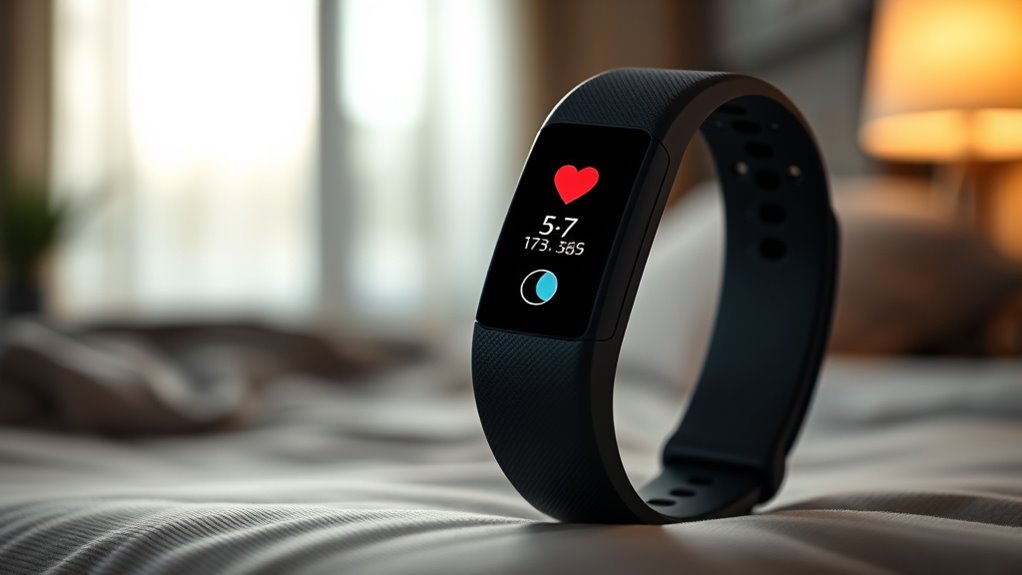
Sleep trackers use a combination of sensors and algorithms to monitor your sleep patterns. The core of their effectiveness lies in wearable sensor technology, which detects various bodily signals such as movement, heart rate, and sometimes even skin temperature. This data is processed through sophisticated algorithms to analyze your sleep stages and overall quality. Sleep tracker accuracy depends on the quality of these sensors and how well the device interprets the signals. Many modern devices use accelerometers to track movement and heart rate monitors to assess physiological changes during sleep. Because of advancements in wearable sensor technology, these trackers provide increasingly reliable insights, helping you understand your sleep habits better. The inclusion of sensor calibration ensures that data collection remains precise over time, further improving the device’s reliability. While they may not be perfect, they offer a valuable glimpse into your nightly rest.
How Sleep Trackers Detect Movement and Restlessness

Many sleep trackers rely on accelerometers—small sensors that detect even the tiniest movements—to monitor your rest. These devices analyze your sleep movement to identify periods of restlessness or quiet sleep. When you shift or toss, the accelerometer records these movements, revealing restless behavior. This data helps distinguish between light and deep sleep stages based on activity levels. Additionally, some advanced projectors incorporate high refresh rates, which can improve the accuracy of movement detection during sleep tracking.
Monitoring Heart Rate and Its Significance
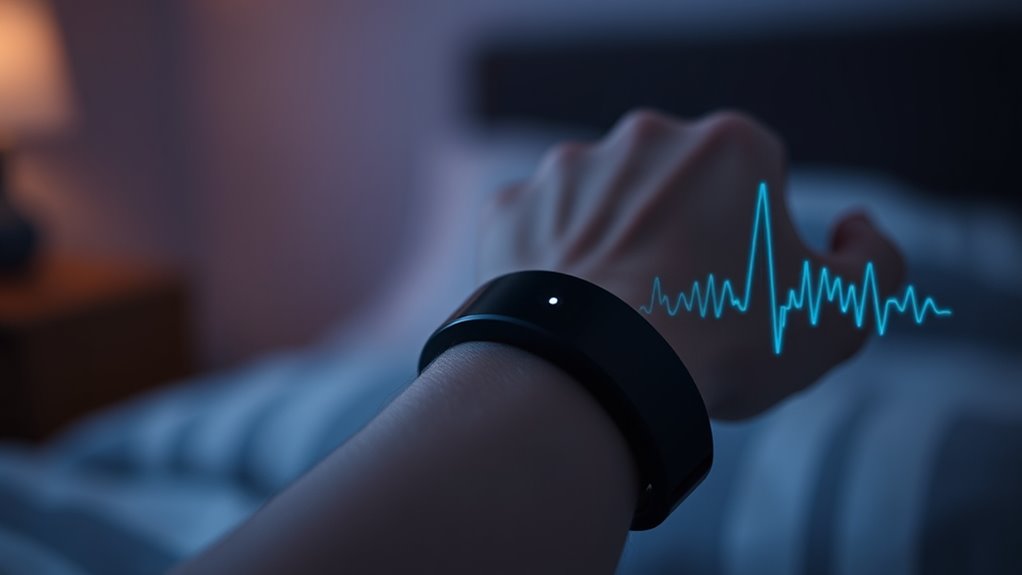
Monitoring your heart rate provides valuable insights into your sleep quality. Variations in heart rate variability can reveal how restful your sleep truly is and help identify different sleep stages. Understanding these metrics allows you to track your progress and improve your overall sleep health. Incorporating expert voice actors into your analysis can enhance the clarity and reliability of your data interpretation.
Heart Rate Variability
Heart rate variability (HRV) measures the fluctuations in time between your heartbeats, offering valuable insights into your body’s stress levels and overall health. By tracking HRV, you can better understand how your circadian rhythms influence your recovery and alertness. Higher HRV generally indicates a well-balanced nervous system, while lower HRV suggests stress or fatigue. This metric also emphasizes the importance of sleep hygiene, as quality sleep supports ideal HRV levels. Additionally, engaging in spiritual practices like meditation has been shown to positively affect HRV by promoting relaxation and emotional balance.
To improve your HRV, consider:
- Maintaining consistent sleep and wake times aligned with your circadian rhythms
- Managing stress through relaxation techniques
- Creating a calming pre-sleep routine to enhance sleep quality
Detecting Sleep Stages
Detecting sleep stages involves analyzing your heart rate patterns to determine when you’re in light, deep, or REM sleep. Your heart rate fluctuates during different phases of sleep, reflecting changes in your dream cycles and overall sleep architecture. As you progress through the night, these variations help sleep trackers identify when you’re experiencing REM sleep, where most dreaming occurs, or deep sleep, essential for physical restoration. Monitoring heart rate provides insights into your body’s shifts between sleep stages, offering a detailed picture of your sleep quality. Additionally, some advanced devices incorporate additional sensors to enhance the accuracy of sleep stage detection. By understanding these patterns, sleep trackers can map out your sleep architecture, revealing how much time you spend in each stage. This information helps you optimize sleep routines and improve overall rest, making your sleep data more meaningful.
Analyzing Breathing Patterns During Sleep
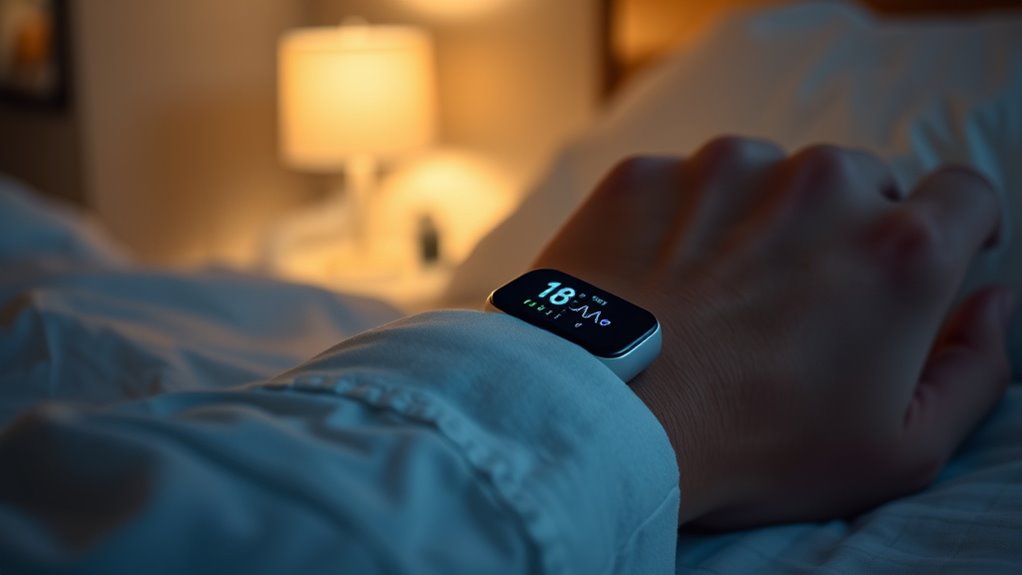
Breathing patterns during sleep reveal essential information about your overall health and sleep quality. Sleep trackers monitor your breathing rate, depth, and irregularities, offering insights into your sleep environment and potential issues like sleep apnea. By analyzing these patterns, you can gain a better understanding of how your body is resting and recovering. These devices often use sensors to detect:
- Variations in breathing rhythm that may indicate disrupted sleep or stress
- Changes in breathing amplitude linked to different sleep stages
- Irregular breathing patterns that could be signs of underlying health conditions
Understanding the importance of exploration and discovery in these patterns can help you identify subtle changes that might otherwise go unnoticed. While dream analysis isn’t directly related, understanding your breathing helps create a complete picture of your sleep quality. Tracking these metrics enables you to make adjustments for better rest and overall well-being.
Sleep Stages and How Trackers Differentiate Them

Understanding your sleep stages is essential for evaluating sleep quality, and sleep trackers distinguish these stages by analyzing specific physiological signals. They monitor movements, heart rate, and breathing patterns to identify light sleep, deep sleep, REM, and wakefulness. During REM sleep, some advanced trackers even perform dream analysis, detecting rapid eye movements associated with vivid dreaming. Your sleep environment—such as room temperature, noise, and light—can influence these stages, so trackers often consider external factors to improve accuracy. By differentiating these stages, your device provides insights into sleep continuity and overall restfulness. Recognizing how your sleep cycles progress helps you adjust habits or environment to optimize rest and recovery, ensuring you get the most out of your sleep each night. Additionally, understanding the role of sleep science can help you interpret data more effectively and make informed decisions about your sleep health.
Interpreting Data: What Metrics Can Tell You About Your Sleep Quality
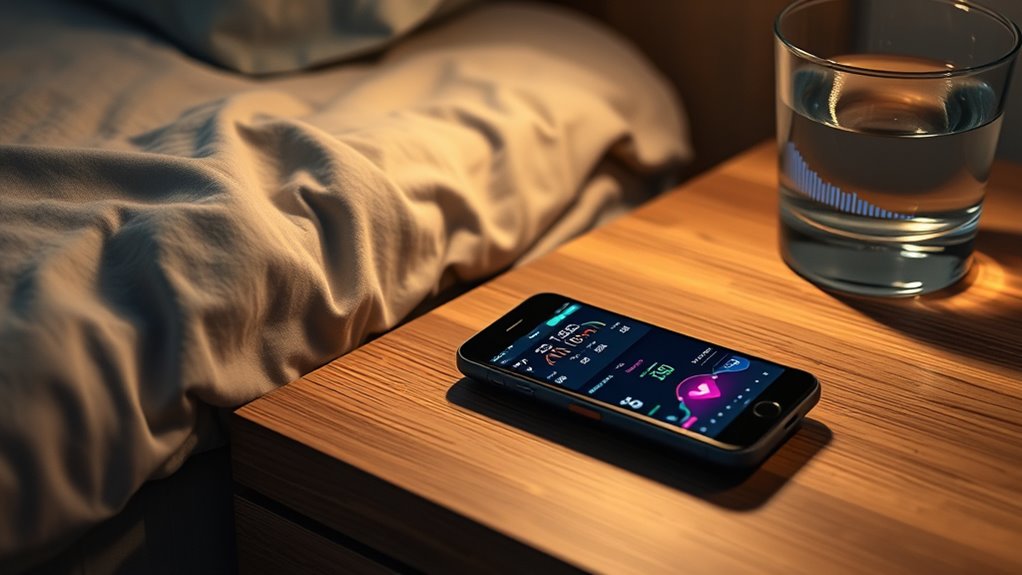
Your sleep tracker gathers various metrics that, when interpreted correctly, can reveal how well you’re resting. Key data points include sleep duration, which shows how long you sleep each night, and insights from dream analysis, offering glimpses into your subconscious. By examining these metrics, you can identify patterns or disruptions affecting your sleep quality. For example, frequent awakenings or short sleep duration may indicate poor sleep hygiene. Understanding these details helps you make lifestyle adjustments to improve rest. Additionally, analyzing sleep stages and dream activity can reveal emotional or psychological factors impacting sleep. Keeping track of sleep quality indicators over time allows for more accurate assessment and targeted improvements. Keep in mind that consistent tracking and interpretation of these metrics allow you to fine-tune your sleep habits for better overall health.
Frequently Asked Questions
How Accurate Are Consumer Sleep Trackers Compared to Clinical Assessments?
You might wonder about the accuracy of consumer sleep trackers compared to clinical assessments. While they give useful insights into your sleep cycle and heart rate variability, they tend to be less precise than medical devices. Trackers can sometimes misinterpret wakefulness or light sleep, but they’re good for monitoring trends. For detailed, reliable data, especially if you have sleep issues, consulting a healthcare professional remains the best option.
Can Sleep Trackers Detect Sleep Disorders Like Sleep Apnea?
You might wonder if sleep trackers can detect sleep disorders like sleep apnea. While some advanced models claim to identify sleep apnea detection, they aren’t medical tools and often miss sleep disorder symptoms. If you suspect a sleep disorder, it’s best to consult a healthcare professional. Sleep trackers can flag irregularities, but they can’t replace clinical diagnosis for accurate detection and appropriate treatment.
Do Different Brands Measure Sleep Metrics Differently?
Did you know over 20 different sleep tracker brands exist today? When comparing them, you’ll notice brand variability in how they measure sleep metrics. Some focus on heart rate, others on movement, and a few combine multiple data points. This lack of metric standardization means results can differ across brands, so you should consider how each device collects and interprets your sleep data before relying on it for health insights.
How Does External Activity Impact Sleep Tracker Readings?
External factors, like your activity influence, can markedly affect sleep tracker readings. If you’re more active during the day, your device might show deeper sleep or longer sleep duration, as it detects more movement. Conversely, external factors such as noise or light could disrupt your sleep, causing the tracker to record lighter sleep stages. Keep in mind, these external influences can sometimes lead to less accurate sleep data.
Are Sleep Trackers Effective for Children and Elderly Users?
You might wonder if sleep trackers work well for children and elderly users. They can be quite helpful in understanding child sleep habits and elderly sleep patterns, offering insights that encourage better sleep routines. While not perfect, these devices provide valuable data for caregivers and family members. Keep in mind, though, that accuracy may vary, so use the information as a guide rather than a definitive diagnosis.
Conclusion
Now that you know how sleep trackers work, you’re equipped to uncover the secrets of your sleep like a detective solving a mystery. Imagine waking up every morning feeling supercharged, knowing exactly what’s happening during your night—like having a personal sleep scientist in your pocket. With this knowledge, you’ll turn restless nights into vibrant, energizing mornings. Sleep trackers aren’t just gadgets; they’re your ultimate weapon for conquering the sleep monster and mastering your rest!

